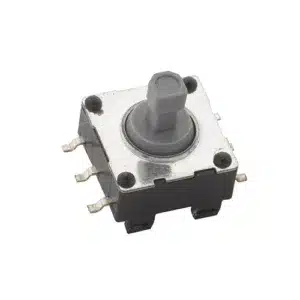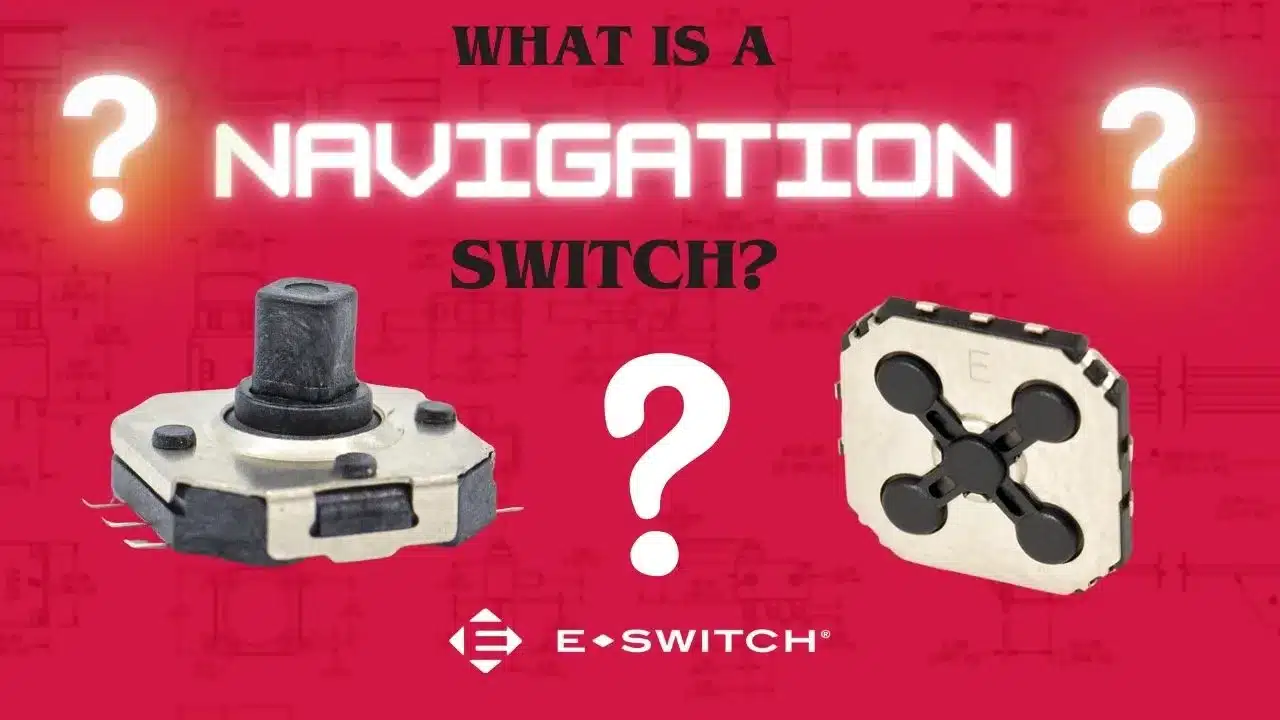What is a Navigation Switch?
Navigation (or joystick) switches are designed for applications that require regular user interface. They are used for navigating through menus, options or interfaces on electronic devices and provide users with an intuitive and tactile way to interact with and navigate through the device’s user interface.
How do They Work?

Navigation switches work by translating physical movements into electrical signals that can be interpreted by electronic devices. The basic components of the switch include sensors, potentiometers or other mechanisms that detect movement, and electronics that convert these movements into signals. Here’s a general overview of how joystick switches work:
1. Mechanical Structure
Handle or Stick: The switch typically has a handle or stick that can be moved in different directions.
Potentiometers or Sensors: Inside the switch, there are potentiometers or sensors that detect the position of the stick in both the X and Y axes. Potentiometers are variable resistors that change their resistance based on the position of the stick.
2. Movement Detection
When you move the joystick, it causes the position of the potentiometers or sensors to change. The movement can be in any direction — up, down, left, right or diagonally.
3. Electrical Signals
The changing resistance or position of the potentiometers generates electrical signals. These signals are then converted into voltage levels that represent the position of the stick in the X and Y axes.
4. Interface with Electronics
The electrical signals are sent to the electronic circuitry within the joystick or the connected device (such as a gaming console or computer).
5. Signal Processing
The electronic circuitry processes these signals and translates them into digital data that can be understood by the device’s software. The data typically includes information about the direction and magnitude of the joystick movement.
6. Communication with Device
The digital data is then transmitted to the connected device through wired or wireless communication.
7. Software Interpretation
The device’s software interprets the received data and uses it to control the movement of an on-screen cursor, character, or other elements in a game or application. Navigation switches can also include additional features, such as buttons integrated into the joystick or triggers on the handle, providing additional input options beyond just directional movement.
It’s important to note that while this explanation provides a general overview, the specific design and technology used in navigation switches can vary between different manufacturers and models.
Pros & Cons
Pros
- Intuitive Control: They offer an intuitive and natural way of controlling movement in various directions.
- Versatility: They are versatile and can be used for a wide range of applications, including gaming, industrial control systems, aviation and more. One of the main advantages for this type of switch is that they can replace five independent switches.
- Precision: They can provide precise control over the movement, especially in applications where fine adjustments are necessary.
- Additional Buttons/Features: Many come with integrated buttons or triggers, expanding the range of available inputs without requiring additional devices.
- User-Friendly: They are often user-friendly, requiring minimal training for users to grasp their functionality.
- Immersive Gaming: In gaming applications, joysticks can enhance the immersive experience, particularly in flight simulations, racing games, and other genres.
Cons
- Limited Degrees of Freedom: They often provide movement along two axes (X and Y), limiting the degrees of freedom compared to more complex input devices.
- Space Requirements: Physical space is required for the movement of the joystick, making them less suitable for compact devices or environments with limited space.
- Not Always Precise: In some applications, the precision of a joystick may not be sufficient, especially when compared to alternatives like touchscreens or mouse-based controls.
- Learning Curve: While generally intuitive, mastering precise control with a joystick may take some time, particularly for complex maneuvers or applications.
What Are Navigation Switches Used For?
Some obvious examples of navigation switches can be found on gaming controllers, digital cameras or most consumer electronics that require any kind of navigational control, like smartphones, tablets, remote controls and control panels.
E-Switch Navigation Switch Offerings
E-Switch currently carries three types of navigation switches: the JS1300, the JS1400 and the JS5208.
At a 9.8mm x 9.8 mm base, the JS1300 is a very low surface mount product, making it a great choice for applications with limited space. The switch has five navigation positions and is covered in a nickel casing, making it a robust choice. As with all current E-Switch navigation switches, the JS1300 has an operating temperature of -20°C to 70°C, making it a well rounded switch for most environments. The JS1300 also has the highest life expectancy of the current E-Switch navigation switches with a reliable 200,000 cycles and a contact rating of 20mA @ 12VDC.
The JS1400 is not only the smallest but has the most customizable features available out of the three switches. It features a five-position joystick, this time with multiple options for the actuator size: 4mm, 4.5mm and 5mm are available. The JS1400 also comes with a choice of flat gullwing or inverted gullwing plating, giving more flexibility for your final applications needs. This switch sports 100,000 mechanical life with a contact rating of 50mA @ 15 VDC. The JS1400’s compact size makes it a great choice for small handheld devices and wearables.
Finally, the JS5208 — again a five-position surface mount switch, however this is the largest navigation switch available with a 12.4mm x 12.4mm base. Its bigger size makes it a great choice for larger applications that require more precise, user friendly navigation. The life expectancy for this switch is 100,000 cycles with a contact rating of 20mA @ 15VDC.
